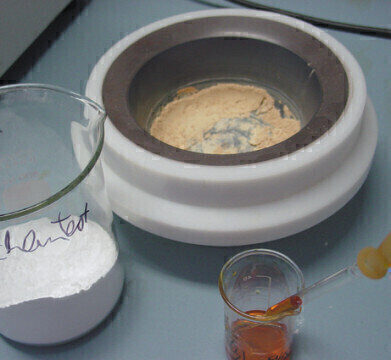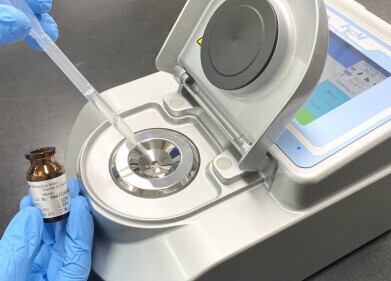Laboratory Products
Production of Mixtures on a Laboratory Scale
Oct 11 2011
Mixed were solid with solid substances, solid with liquid substances and liquids with solids. As solid phases mostly fine powders are used, which during the mixing process should not be further reduced. The liquid phases include
mercury to saline solutions up to resins.
Probably one of the most difficult tasks was the fine distribution of pure liquid mercury in a mixture of fine solid metal powders. Already during the manual mixing with a spatula, with careless work methods without a problem up to 3mm large amalgam grains were produced. The solution was added to the mortar mill PULVERISETTE 2, with an agate grinding set and special adjustments for the minimising of the application of energy found.
From the area of mixtures liquid – solid is the production of filled pastes to be mentioned. Especially challenging here is to add as much as possible solids in the high viscosity organic phase.
An additional example for this is, when one has to add to organic binder (for example synthetic resin or varnish or in the
simplest case oil) fine metallic, ceramic or inorganic powders. High viscosity pastes evolve which can be compared which shoe polish in a tube. Experts often talk about filled composite materials. Often the increase of the degree of the solid content is the goal of all activities.
In this concrete case, was a metallic powder to be added to a synthetic resin of high viscosity. Chosen was the Fritsch
mortar mill PULVERISETTE 2, equipped with a grinding set of hardened steel. With processing times of up to 30 minutes, the successive addition of the powder and supported by the slight warming from the applied comminution energy, up to 80% of the mass percentage of the solid was homogenously mixed in. From the areas of mixtures solid – liquid the contamination of ceramic powders with very little amounts of solved in liquid substances are to be mentioned. For the test the mortar mill PULVERISETTE 2 with an agate grinding set was chosen.
The iron nitrate solution was used as the model-solution coloured and therefore the homogeneity of the mixture was very easily visually evaluated. While the mill was grinding, approximately 1ml liquid in 50g powder were instilled. Afterwards it was further homogenised. After 5 minutes a visual consistent system was created.
Digital Edition
Lab Asia 31.2 April 2024
April 2024
In This Edition Chromatography Articles - Approaches to troubleshooting an SPE method for the analysis of oligonucleotides (pt i) - High-precision liquid flow processes demand full fluidic c...
View all digital editions
Events
May 05 2024 Seville, Spain
InformEx Zone at CPhl North America
May 07 2024 Pennsylvania, PA, USA
May 14 2024 Oklahoma City, OK, USA
May 15 2024 Birmingham, UK
May 21 2024 Lagos, Nigeria





.jpg)












